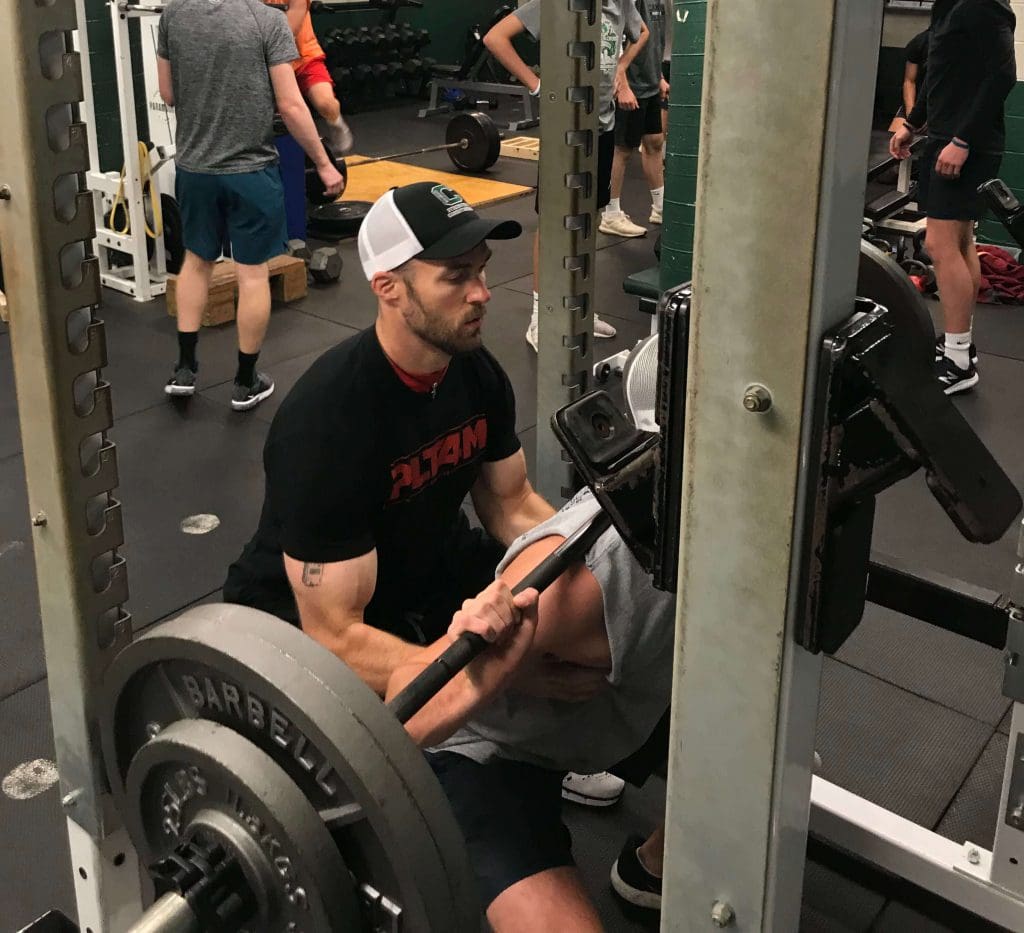[vc_row][vc_column width=”1/4″][vc_single_image image=”6930″ img_size=”medium”][/vc_column][vc_column width=”3/4″][vc_column_text]
Meet The Author: Adam Hughes; B.S., M.S.Ed, CSCS, BMC, CPT
- Health and Wellness Teacher
- Head Strength and Conditioning Coach
- PLT4M Coaches Club Ambassador
Performance Stations – Strength and Conditioning That Builds The Total Athlete
In my personal journey as a strength and conditioning coach, I have grown to appreciate the importance of training the complete athlete. This term, ”complete athlete” goes beyond the basic elements of strength, speed, agility, and conditioning training. Instead, training the complete athlete means developing an athlete to perform at a championship level for an entire season and career. As a strength and conditioning coach, I use ”performance-driven stations’ within each workout to help build the complete athlete. The concept of performance stations is an element I acquired through a strength and conditioning great and my mentor Mike Barwis CSCS of Barwis Methods. (You can see more about Barwis here.) These stations are intended to tap into unique elements of what athletes need to perform and stay healthy throughout a season. Most people would interpret performance solely as things connected to sport-specific or explosive movements. However, in the case of this article, performance stations incorporate:1: Balance and Functional Training
2: Injury Prevention
3: Core and Flexibility Training
4: Plyometric and Impulse Training
Throughout the season, these stations help athletes maintain performance, health, and durability so that they can compete and perform at a higher level all season long.SETTING THE STAGE
While the traditional elements of strength and conditioning are layered throughout our programs, utilizing these stations helps to fill in gaps and holes that complete our athlete’s performance. For context, each day within a three day, week-long training microcycle contains elements of these performance stations in some combination. Balance and Functional Training and Core and Flexibility Training are present within two of the three days. Injury Prevention and Plyometric and Impulse Training are incorporated within all three days during the cycle. Additionally, the Injury Prevention and Core and Flexibility Training elements are also done throughout the season on days either right before a competition for athlete preparation. They are also done on days immediately following competition for recovery.BALANCE AND FUNCTIONAL TRAINING
The Balance and Functional Training station is an element that helps athletes learn how to adapt and adjust to constant changes within their sports. The focus of balance and functional work is to provide athletes with a stimulus that forces their central nervous system and musculoskeletal system to adapt and change while maintaining balance and stability. The use of these types of exercises helps athletes to react and respond to changes that occur during gameplay, such as falling or getting knocked off balance. In common situations where athletes get knocked off balance during gameplay, they typically struggle to regain equilibrium to continue their high level of play immediately. The use of constant balance and stability work helps athletes learn to adapt to change or loss of equilibrium quicker so that they can continue to play at a high level despite minor disruptions that can and do occur constantly.Example of Balance and Functional Progression:
- Sitting on a balance ball for time
- Progressing to kneeling on the ball with both knees
- Kneeling on the ball with one knee and placing one foot on the ball
- Eventually progressing to standing on the ball unassisted for set lengths of time
Other Examples of Balance and Functional Exercises:
- Standing on a dyna-disc with one foot while performing single-leg squats,
- Walking and squatting on balance pods or stepping stones,
- Standing on vew-do balance boards
- Performing single-leg exercises with medicine balls,
- Utilizing Bosu balls for both upper and lower body stability,
- Performing lightweight resisted exercises on balance balls, dyna discs, and Bosu balls.
INJURY PREVENTION
Perhaps the most critical element of our performance stations is our Injury Prevention Station. In this station, athletes go through a weekly regimen of exercises to help stabilize critical and commonly injured structures within their bodies (specific to their sports). While no exercise or regimen can 100% prevent injuries from happening, these specific exercises can help to reduce the severity of injuries when they do occur.Injury Prevention Exercise Examples:
- Band resisted ankle mobility and strengthening
- Manually resisted neck capsule strengthening to help prevent and limit the likelihood of concussions
- Shoulder joint and rotator cuff strengthening
- Knee ligament strengthening
CORE AND FLEXIBILITY
Our Core and Flexibility Training are the two stations that take great importance on two days within a microcycle. These are intended to help expand our athletes ability to perform in all other areas of their strength and conditioning training. Core strength and stability correlates to athlete balance and strength within training and overall performance. Additionally, improving and enhancing flexibility corresponds to our injury prevention focus. The use of these two stations cannot be overstated when it comes to their integral importance in developing the total athlete. While most athletes would view these two stations as only doing some crunches and some static stretching before or after a workout, we take these things to a much more dynamic level. We do so by having multiple cycles and groupings of exercises to provide our athletes with a comprehensive focus around these two elements of athletic performance.Day 1 Core
- Balance Ball Crunches
- Medicine Ball Russian Twists
- Medicine Ball Sit-ups
- Balance Ball Hypers/Back Extensions
Flexibility Week 1
- Backward Lunge & Twist
- Cat & Cow
- Walking Toe Touch
- Bar Lat Stretch
- Leg Swings Front to Back
Check out how PLT4M can parnter with you to help manage your weight room!
[/vc_column_text][/vc_column][/vc_row][vc_row][vc_column][vc_row_inner][vc_column_inner width=”1/3″][/vc_column_inner][vc_column_inner width=”1/3″][vc_btn title=”Request A Demo” el_class=”red_button” link=”url:https%3A%2F%2Fwww.plt4m.com%2Fwant-to-see-more%2F|title:Want%20to%20See%20More%3F||”][/vc_column_inner][vc_column_inner width=”1/3″][/vc_column_inner][/vc_row_inner][/vc_column][/vc_row][vc_row][vc_column][vc_separator][/vc_column][/vc_row][/vc_section][vc_row][vc_column][vc_column_text]PLYOMETRIC AND IMPULSE
The last and certainly the most dynamic performance station that our athletes go through is our Plyometric and Impulse station. This station is exclusively reserved for our off-season and pre-season training groups. Beginning with focusing on proper landing technique and form, we progress athletes to a high explosion style of exercise. This station comprises a day of upper body driven plyometric exercises and a day of lower body driven exercises. Finally, we combine a combination of both upper and lower body plyometric exercises on our final day for each microcycle. The start of a macrocycle begins with athletes establishing proper technique in conjunction with a higher volume. We balance higher plyometric volume with lower strength training volume. Our upper body plyometric days are paired with lower body strength training days. Inversely lower body plyometric days are paired with upper body strength training. We progress from using higher repetitions and volume at the beginning of a macrocycle to less volume and a combination style movements. The combination style of exercises focus on power transfer and helping our athletes prepare for the explosiveness and impulse for their sports. We use a wide variety of exercises during this station each day to help target maximum explosion and drive within our athletes upper and lower body. Depending on the timing during the macrocycle, athletes will perform anywhere from 5-8 exercises exclusively within this station. The timing of our training each week makes sure that because of the high intensity and impact that this station brings, our athletes have at least 48 hours between sessions for optimal recovery.Example of Plyometric Progression:
- Multiple Height Box Jumps
- In-depth and rotational box jumps
- Reactive box jumps into broad jumps








